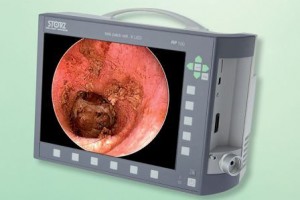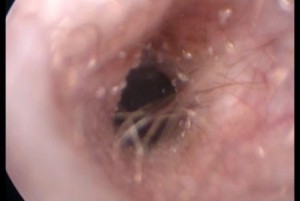 An endoscope is a special piece of medical imaging equipment that is used to look inside a body cavity or organ. By using a highly advanced camera attached to a light source, an endoscope sees inside places that might otherwise be impossible to visualise or require major surgery to access. As a relatively non-invasive procedure, endoscopy can be used to examine and diagnose many medical conditions. It can be used to look down ears, up noses, down throats and even up the other end!
An endoscope is a special piece of medical imaging equipment that is used to look inside a body cavity or organ. By using a highly advanced camera attached to a light source, an endoscope sees inside places that might otherwise be impossible to visualise or require major surgery to access. As a relatively non-invasive procedure, endoscopy can be used to examine and diagnose many medical conditions. It can be used to look down ears, up noses, down throats and even up the other end!
The image produced by an endoscope is full-colour and magnified. As such even the smallest problems can be detected.
Karingal Veterinary Hospital has invested in advanced endoscopic equipment – the Karl Storz Tele Pack Vet X unit allows us to obtain incredibly clear images and videos and save them to a patient’s medical record for future reference. Not only can we get great images we are also able to obtain samples for lab testing via our endoscopic equipment. Samples such as tissue biopsies, fluid and samples for bacterial culture can all be obtained using instruments put down through the endoscope without the need for invasive surgery. Endoscopy is performed under general anaesthesia so it does not hurt at all. How it is conducted varies, depending on exactly what we are scoping.
Otoscopy
Otoscopy is a specific type of endoscopic examination looking down the ears. Ear problems are common in dogs and cats, in particular ear infections. While many of these can be resolved with medication alone, sometimes there is a need to examine inside the ears in more detail. Reasons for this include when an infection is not responding to medication as expected or there is the possibility of a foreign object such as a grass seed down the ear.
At Karingal Vet Hospital we use a special type of endoscope called an otoscope. This instrument allows excellent visualisation down the ear. It is also very useful for looking up noses too. Fluid can be flushed through the scope to clean out the ears and samples can be obtained for further testing if required.
 Flexible Endoscope
Flexible Endoscope
In order to get images from in the trachea, lungs, oesophagus, stomach and intestines a long, flexible endoscope is required. These types of endoscopes vary in diameter and length. They are also very expensive pieces of equipment so not many veterinary practices are equipped with a flexible endoscope. Using a flexible endoscope requires lots of practice and a special set of skills. At Karingal Veterinary Hospital our veterinarians are well versed in operating our flexible endoscope.
Rigid Endoscope
A third type of endoscope we use is called a rigid endoscope. This scope is approximately 20 cm long and contains very advanced imaging capabilities. It is often used to examine inside the body cavities of our smaller patients such as reptiles and birds.